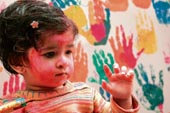 |
| Hand of holi: A toddler enjoys a splash of colours a day before Holi at Prerna Montessori in Lake Road on March 2. Picture by Sanjoy Chattopadhyaya |
In Sudan, they call a water pump Unicef. And courtesy Audrey Hepburn and her new huckleberry friend, villages in South 24-Parganas and the Sunderbans might soon start calling their primary schools by some other name — Dominique, perhaps.
The French writer Dominique Lapierre is back on his mission in the small villages of South 24-Parganas on February 28, with 60, 07,222 Euros got from the auction of Hepburn’s Breakfast at Tiffany’s Givenchy costume (with long black gloves and a huge pearl choker) at Christie’s auction house in London.
The money is used to set up Bodhodaya Vidya Mandir Primary School in Lakshmikantapur and Dominique Lapierre Centre of Excellence for Disable, home for mentally challenged women in Keoradanga, near Amtala, some 25 km from Calcutta. Both the institutes are dedicated to Audrey Hepburn.
 |
“I have a small surprise for everyone,” said Lapierre at the inauguration ceremony in the small village of South 24-Parganas (picture by Bishwarup Dutta).
There were posters and cutouts of Hepburn, a goodwill ambassador once again, 14 years after her death from colon cancer. From the jazziest of her cinematic roles, Hepburn beams from her little black cocktail dress, on posters stuck on mud walls, off narrow winding roads that have never known asphalt.
Dr Bernard Rouveix, a Parisian doctor serving with voluntary agencies in Somalia, Mali and Kenya, accompanied Dominique and his wife. “I am moved with the response Dominique excites in the villages,” he said.
There’s reason for that. Three hospital boats, donated by Lapierre, have treated 1,00,000 people for tuberculosis in the Sunderbans and performed 3,000 operations in the confines of a floating operation room.
His eye hospitals perform almost 30 cataract operations each day. And in the course of 20 years, Lapierre’s City of Joy Foundation has rescued 9,000 children suffering from leprosy and other diseases caused by malnutrition and poverty. He has also set up schools for the socially vulnerable.
Lapierre spends all of his books’ royalties (about $ 3 million a year) on the Sunderbans and for victims of the Bhopal gas disaster.
A huge crowd attended the inauguration. Unknown village children huddled beside green ponds, staring agape at their favourite Dominique dada, didi, and all their French and Italian friends.
Lapierre pulled out a Calcutta hand-rickshaw puller’s bell from his pocket and started ringing like a child at the inauguration programme. “This is my Calcutta mobile phone,” he laughed.
“When I walk the Paris streets, this rings to remind me of my friends here,” said the 76-year-old author of the 1984 novel The City of Joy, which has sold nine million copies worldwide.
On March 1, Lapierre climbed into one of his famous hospital boats with his wife and friends for a trip to his Sunderbans projects. There’s also research work to be done for his next book.
“My next book will be an investigation on the ecological hazards that are ravaging Sunderbans.”
Will it be controversial? “I am never controversial,” said Lapierre as there was call waiting on his “Calcutta cell phone.”
Deeptanil Roy
Only Connect
Whole new world of e-words
It is exam time and “Only Connect” will don its professorial hat to talk about various weighty matters. “Only Connect” has recently been poring over a rather clever book called From Gutenberg to Google, written by Peter Shillingsburg, a professor of English at De Montfort University. As the name suggests, it discusses the transformation of printed words into digital words, and what it means for reading and scholarship.
Since this is a Saturday morning column, we will forget about scholarship for the time being and consider the act of reading. Electronic reading is not a fun thing to do. Imagine reading the whole of Ulysses off a computer screen!
But we do not read James Joyce on a daily basis, whereas we do read e-mails several times a day, if not hour. We read websites, forums, blogs, chats on a fairly regular basis as well. None of these require very sophisticated reading skills or a lengthy attention span. Few of these require the eye to traverse the entire length of the computer screen from left to right, and then back again at the left margin.
A paper book (or hard copy) requires a more physical response from the reader. We can curl up with a book in bed, or take it to the toilet, or even read it while hanging on in a crowded bus. If we have a pencil handy, we could even underline or make marginal notes (I am not recommending this, mind you). In other words, it is possible to develop an intimate relationship with a book which goes beyond the role that it usually performs. (How about using your copy of Ulysses to stun burglars?)
The electronic word, on the other hand, can do ‘oh so many things’ more than printed words. Printed words can do just one thing: it can indicate a value (or meaning) that has been pre-assigned to it. It sits there on the page, doing nothing.
The electronic word can grow and shrink like Alice, change colour and font, or even do Las Vegas lights if it is feeling happy. But there are two things it can do that really distinguish it from the printed word. It can look for other words like itself, and it can transform itself into a link.
So if we take the word ‘book’ and ask it to do a search in a document, it can tell me instantly how many times the word ‘book’ occurs in it. It can even tell me if there are words that are similar to it, depending on the capacity of the computer programme which supports it. For example, I have just found out that I have used the word ‘book’ seven times in this article. And I also find that I have used up over 450 words, which is pretty much the limit for this column.
Next week: In which we try to make sense of OCR










